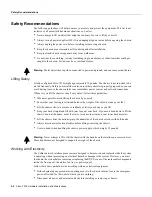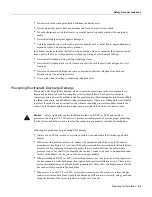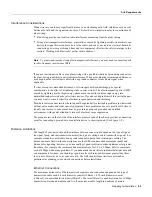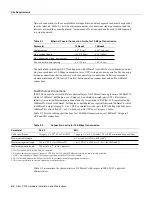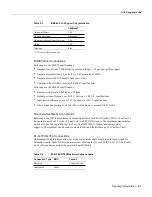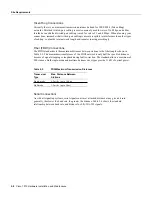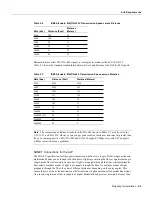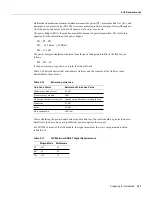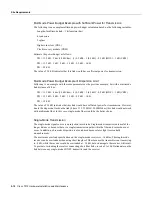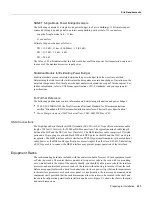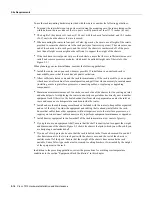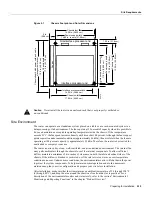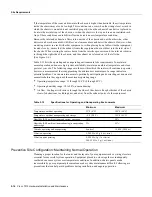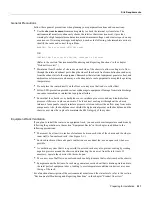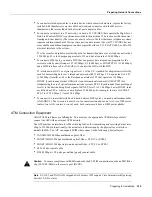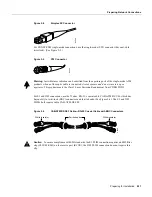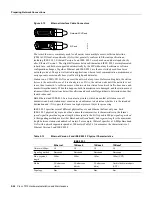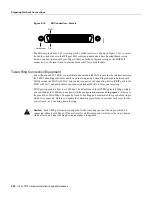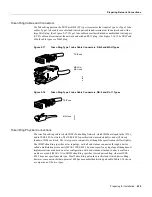
2-16 Cisco 7010 Hardware Installation and Maintenance
Site Requirements
If the temperature of the room air drawn into the chassis is higher than desirable, the air temperature
inside the chassis may also be too high. This condition can occur when the wiring closet or rack in
which the chassis is mounted is not ventilated properly, when the exhaust of one device is placed so
it enters the air inlet vent of the chassis, or when the chassis is the top unit in an unventilated rack.
Any of these conditions can inhibit air flow and create an overtemperature condition.
Because the inlet and exhaust air flows into one side of the chassis and out the other side, other
devices can be rack-mounted with little or no clearance above and below the chassis. However, when
mounting a router in a rack with other equipment, or when placing it on a table with other equipment
located close by, ensure that the exhaust from other equipment does not blow into the inlet side of
the chassis. When viewing the router chassis from the interface processor end, the inlet air is drawn
in through the right side of the chassis, and the exhaust air is forced out of the left side.
(See Figure 1-6.)
Table 2-12 lists the operating and nonoperating environmental site requirements. To maintain
normal operation and ensure high system availability, maintain an ambient temperature and clean
power at your site. The following ranges are those within which the router will continue to operate;
however, a measurement that is approaching the minimum or maximum of a range indicates a
potential problem. You can maintain normal operation by anticipating and correcting environmental
anomalies before they approach the maximum operating range.
•
Operating temperature range: 32 through 104°F (0 through 40°C).
•
Operating humidity range: 10 to 90%, noncondensing.
•
Air flow: Cooling air is drawn in through the sides of the chassis. Keep both sides of the chassis
clear of obstructions, including dust, and away from the exhaust ports of other equipment.
Table 2-12
Specifications for Operating and Nonoperating Environments
Preventive Site Configuration: Maintaining Normal Operation
Planning a proper location for the router and the layout of your equipment rack or wiring closet are
essential for successful system operation. Equipment placed too close together or inadequately
ventilated can cause system overtemperature conditions. In addition, chassis panels made
inaccessible by poor equipment placement can make system maintenance difficult. Following are
precautions that can help avoid problems during installation and ongoing operation.
Minimum
Maximum
Temperature, ambient operating
32°F (0°C)
104°F (40°C)
Temperature, ambient nonoperating and storage
–4°F (-20°C)
149°F (65°C)
Humidity (RH), ambient (noncondensing) operating
10%
90%
Humidity (RH), ambient (noncondensing) nonoperating
and storage
5% 95%
Altitude, operating and nonoperating
Sea level
10,000' (3050 m)
Vibration, operating
5–200 Hz, 0.5 g (1 oct./min.)
–
Vibration, nonoperating
5–200 Hz, 1 g (1 oct./min.)
200–500 Hz, 2 g (1 oct./min.)
–
Summary of Contents for TelePresence Server 7010
Page 10: ...x Cisco 7010 Hardware Installation and Maintenence ...
Page 14: ...iv Cisco 7010 Hardware Installation and Maintenance Document Conventions ...
Page 148: ...3 36 Cisco 7010 Hardware Installation and Maintenance Using the Flash Memory Card ...
Page 158: ...4 10 Cisco 7010 Hardware Installation and Maintenance Troubleshooting the Processor Subsystem ...
Page 242: ...5 84 Cisco 7010 Hardware Installation and Maintenance Replacing Internal Components ...
Page 258: ...A 16 Cisco 7010 Hardware Installation and Maintenance MIP Interface Cable Pinouts ...
Page 270: ...B 12 Cisco 7010 Hardware Installation and Maintenance Interface Processor LEDs ...
Page 274: ...C 4 Cisco 7000 Hardware Installation and Maintenance ...
Page 287: ...Index 13 ...

